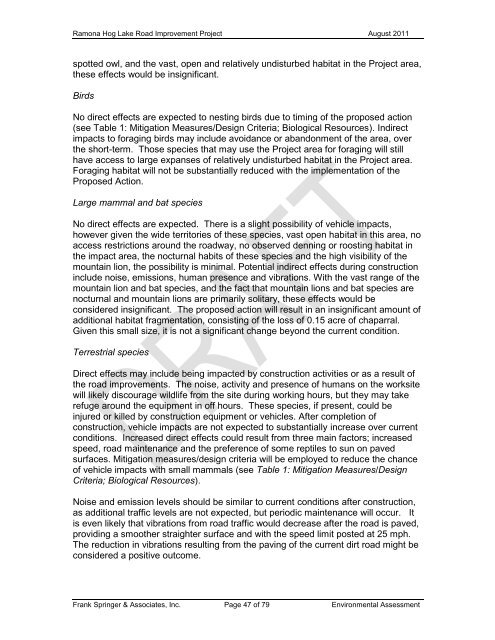environmental assessment for the hog lake road improvement project
environmental assessment for the hog lake road improvement project
environmental assessment for the hog lake road improvement project
You also want an ePaper? Increase the reach of your titles
YUMPU automatically turns print PDFs into web optimized ePapers that Google loves.
Ramona Hog Lake Road Improvement Project August 2011<br />
spotted owl, and <strong>the</strong> vast, open and relatively undisturbed habitat in <strong>the</strong> Project area,<br />
<strong>the</strong>se effects would be insignificant.<br />
Birds<br />
No direct effects are expected to nesting birds due to timing of <strong>the</strong> proposed action<br />
(see Table 1: Mitigation Measures/Design Criteria; Biological Resources). Indirect<br />
impacts to <strong>for</strong>aging birds may include avoidance or abandonment of <strong>the</strong> area, over<br />
<strong>the</strong> short-term. Those species that may use <strong>the</strong> Project area <strong>for</strong> <strong>for</strong>aging will still<br />
have access to large expanses of relatively undisturbed habitat in <strong>the</strong> Project area.<br />
Foraging habitat will not be substantially reduced with <strong>the</strong> implementation of <strong>the</strong><br />
Proposed Action.<br />
Large mammal and bat species<br />
No direct effects are expected. There is a slight possibility of vehicle impacts,<br />
however given <strong>the</strong> wide territories of <strong>the</strong>se species, vast open habitat in this area, no<br />
access restrictions around <strong>the</strong> <strong>road</strong>way, no observed denning or roosting habitat in<br />
<strong>the</strong> impact area, <strong>the</strong> nocturnal habits of <strong>the</strong>se species and <strong>the</strong> high visibility of <strong>the</strong><br />
mountain lion, <strong>the</strong> possibility is minimal. Potential indirect effects during construction<br />
include noise, emissions, human presence and vibrations. With <strong>the</strong> vast range of <strong>the</strong><br />
mountain lion and bat species, and <strong>the</strong> fact that mountain lions and bat species are<br />
nocturnal and mountain lions are primarily solitary, <strong>the</strong>se effects would be<br />
considered insignificant. The proposed action will result in an insignificant amount of<br />
additional habitat fragmentation, consisting of <strong>the</strong> loss of 0.15 acre of chaparral.<br />
Given this small size, it is not a significant change beyond <strong>the</strong> current condition.<br />
Terrestrial species<br />
Direct effects may include being impacted by construction activities or as a result of<br />
<strong>the</strong> <strong>road</strong> <strong>improvement</strong>s. The noise, activity and presence of humans on <strong>the</strong> worksite<br />
will likely discourage wildlife from <strong>the</strong> site during working hours, but <strong>the</strong>y may take<br />
refuge around <strong>the</strong> equipment in off hours. These species, if present, could be<br />
injured or killed by construction equipment or vehicles. After completion of<br />
construction, vehicle impacts are not expected to substantially increase over current<br />
conditions. Increased direct effects could result from three main factors; increased<br />
speed, <strong>road</strong> maintenance and <strong>the</strong> preference of some reptiles to sun on paved<br />
surfaces. Mitigation measures/design criteria will be employed to reduce <strong>the</strong> chance<br />
of vehicle impacts with small mammals (see Table 1: Mitigation Measures/Design<br />
Criteria; Biological Resources).<br />
Noise and emission levels should be similar to current conditions after construction,<br />
as additional traffic levels are not expected, but periodic maintenance will occur. It<br />
is even likely that vibrations from <strong>road</strong> traffic would decrease after <strong>the</strong> <strong>road</strong> is paved,<br />
providing a smoo<strong>the</strong>r straighter surface and with <strong>the</strong> speed limit posted at 25 mph.<br />
The reduction in vibrations resulting from <strong>the</strong> paving of <strong>the</strong> current dirt <strong>road</strong> might be<br />
considered a positive outcome.<br />
Frank Springer & Associates, Inc. Page 47 of 79 Environmental Assessment
















